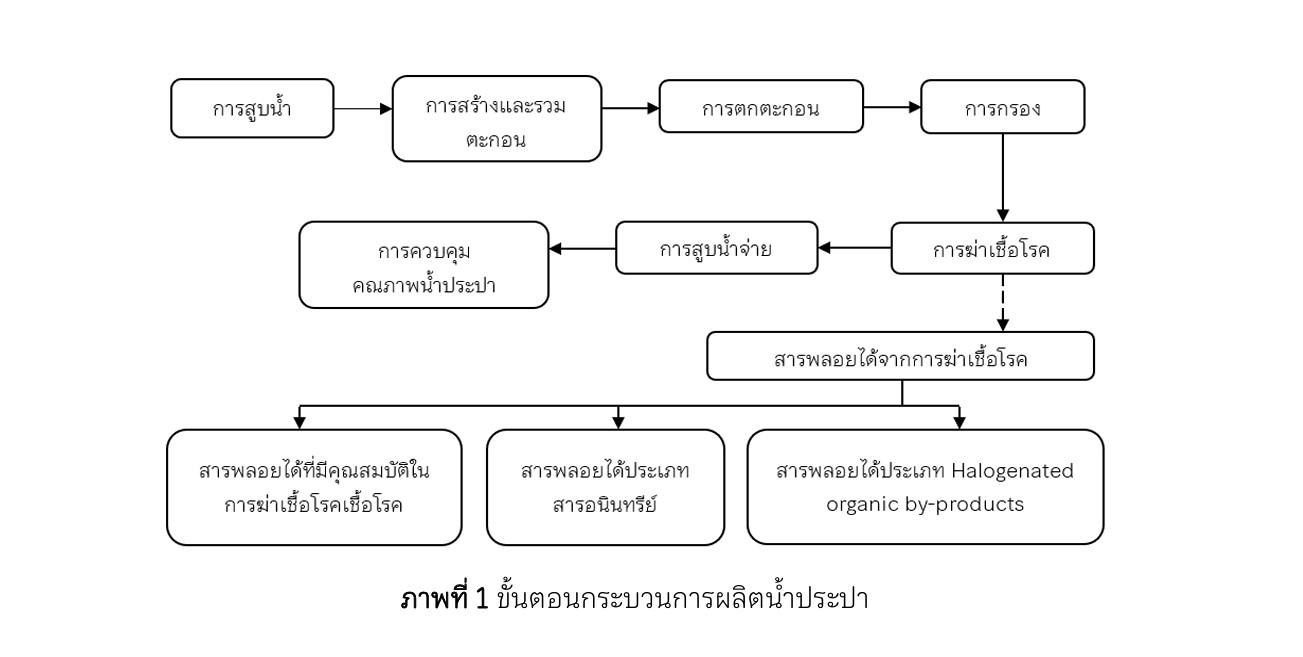การควบคุมการเกิดกรดฮาโลอะซิติกจากการฆ่าเชื้อโรคด้วยสารคลอรีนของระบบผลิตน้ำประปา
คำสำคัญ:
กรดฮาโลอะซิติก , การฆ่าเชื้อโรคด้วยคลอรีน , น้ำประปาบทคัดย่อ
การศึกษาโดยการรวบรวมข้อมูลจากบทความทางวิชาการและงานวิจัยที่เกี่ยวข้องกับกรดฮาโลอะซิติกเพื่อเป็นข้อมูลสำหรับการปรับปรุงและการพัฒนาระบบผลิตน้ำประปาให้ดีขึ้น กรดฮาโลอะซิติกเป็นสารพลอยได้จากการฆ่าเชื้อโรคเกิดขึ้นจากปฏิกิริยาทางเคมี ระหว่างสารอินทรีย์ธรรมชาติในน้ำดิบกับสารคลอรีนที่ใช้ฆ่าเชื้อโรค ซึ่งความเข้มข้นของการเกิดกรดฮาโลอะซิติกอาศัย 5 ปัจจัย ได้แก่ ความเข้มข้นของสารอินทรีย์ธรรมชาติในน้ำ ความเข้มข้นของสารคลอรีน อุณหภูมิ พีเอช และระยะเวลาสัมผัส โดยกรดฮาโลอะซิติกมีศักยภาพสามารถก่อมะเร็งในมนุษย์ สามารถเข้าสู่ร่างกายจากการดื่ม-กิน การซึมผ่านผิวหนัง และการหายใจ นอกจากนี้กรดฮาโลอะซิติกสามารถคงค้างในสิ่งแวดล้อมได้นานกว่า 63 วัน ซึ่งทำให้เกิดการสะสมในห่วงโซ่อาหารได้ ดังนั้นต้องมีการควบคุม 5 ปัจจัยหลักให้เหมาะสม หรือใช้เทคโนโลยีในการกำจัดกรดฮาโลอะซิติกโดยตรง เช่น การใช้เมมเบรนที่มีประสิทธิภาพการกำจัดสูงถึงร้อยละ 90-100
Downloads
เอกสารอ้างอิง
ชัยยศ ตั้งสถิตย์กุลชัย. (2554). กระบวนการดูดซับสาร. นครราชสีมา. สำนักพิมพ์มหาวิทยาลัยเทคโนโลยีสุรนารี.
ประพัฒน์ เป็นตามวา. (2555). การประปาชุมชนเมืองและชนบท. นครราชสีมา. ศูนย์บรรณสารและสื่อการศึกษามหาวิทยาลัยเทคโนโลยีสุรนารี.
พงศ์ธร แสงชูติ. (2560). การกำจัดกรดฮาโลอะซิติก (HAAs) ในน้ำประปาด้วยกระบวนการสร้างและรวมตะกอนร่วมกับการดูดซับด้วยถ่านกัมมันต์. วิทยานิพนธ์วิศวกรรมศาสตรมหาบัณฑิต สาขาวิชาวิศวกรรมสิ่งแวดล้อม, มหาวิทยาลัยเทคโนโลยีสุรนารี.
มัลลิกา ปัญญคะโป และ ผ่องศรี เผ่าภูรี. (2550). รายงานการวิจัยเรื่องการเกิดสารไตรฮาโลมีเทนในน้ำประปาที่ผ่านการฆ่าเชื้อโรคด้วยคลอรีน กรณีตัวอย่างระบบประปาของเทศบาลนครนครปฐม. ภาควิชาวิทยาศาสตร์สิ่งแวดล้อม, มหาวิทยาลัยศิลปากร.
Babi, K. G., Koumenides, K. M., Nikolaou, A. D., Makri, C. A., Tzoumerkas, F. K., & Lekkas, T. D. (2007). Pilot study of the removal of THMs, HAAs and DOC from drinking water by GAC adsorption. Desalination, 210(1-3), 215-224.
Bond, T., Goslan, E. H., Parsons, S. A., & Jefferson, B. (2012). A critical review of trihalomethane and haloacetic acid formation from natural organic matter surrogates. Environmental Technology Reviews, 1(1), 93-113.
Cheema, W. A., Kaarsholm, K. M., & Andersen, H. R. (2017). Combined UV treatment and ozonation for the removal of by-product precursors in swimming pool water. Water Research, 110, 141-149.
Chuang, Y.-H., Wang, G.-S., & Tung, H.-H. (2011). Chlorine residuals and haloacetic acid reduction in rapid sand filtration. Chemosphere, 85(7), 1146-1153.
Dmitruk, U. & Dojlido, J. (2007). Haloacetic acids (HAAs) in the central waterworks in Warsaw, Poland. Polish Journal of Environmental Studies, 16(1), 51-56.
Ghomshe, S. T., Mousavi, S., Soltanieh, M., & Kordi, A. S. (2011). Batch and column study of haloacetic acids adsorption onto granular activated carbon. Scientific Research and Essays, 6(16), 3553-3560.
Ghomsheh, S. M., Soltanieh, M. O. H. A. M. M. A. D., and Mosavi, M. A. H. M. O. D. (1790). Overview of the separation and removal of haloacetic acids in drinking water. Advances in waste management. 1146-1153.
Guay, C., Rodriguez, M., & Sérodes, J. (2005). Using ozonation and chloramination to reduce the formation of trihalomethanes and haloacetic acids in drinking water. Desalination, 176(1-3), 229-240.
Lu, J., Zhang, T., Ma, J., & Chen, Z. (2009). Evaluation of disinfection by-products formation during chlorination and chloramination of dissolved natural organic matter fractions isolated from a filtered river water. Journal of Hazardous Materials, 162(1), 140-145.
Marhaba, T., & Washington, M. (1998). Drinking water disinfection and by-products: history and current practice. Advances in Environmental Research, 2(1), 103-115.
Nikolaou, A., Lekkas, T., & Golfinopoulos, S. (2004). Kinetics of the formation and decomposition of chlorination by-products in surface waters. Chemical Engineering Journal, 100(1-3), 139-148.
Palumbo, D. J., Andreola, R., Utida, M. A., Teixeira, T. M., Schmidt Filho, E., de Oliveira, J. R., & Fernandes, V. T. (2018). Analysis of haloacetic acids (HAA5) in waters of public schools and residencies in Maringá-Brazil. Journal of Water Resource and Protection, 10(11), 1083-1089.
Ratasuk, C. H. A. L. A. T. I. P., Ratanatamskul, C. H. A. W. A. L. I. T., & Ratasuk, N. O. P. A. W. A. N. (2009). Removal of haloacetic acids by nanofiltration. Journal of Environmental Sciences, 21(1), 96-100.
Ratasuk, C., Kositanont, C., & Ratanatamskul, C. (2008). Removal of haloacetic acids by ozone and biologically active carbon. ScienceAsia, 34(3), 293-298.
Rodriguez, M. J., Serodes, J., & Roy, D. (2007). Formation and fate of haloacetic acids (HAAs) within the water treatment plant. Water Research, 41(18), 4222-4232.
Saengchut, P., Karuchit, S., & Pentamwa, P. (2018). Investigation of haloacetic acids (HAAs) levels in water supply and its correlated HAAs formation. IOP Conference Series: Earth and Environmental Science, 164, 012023.
Tsitsifli, S., & Kanakoudis, V. (2018). Disinfection impacts to drinking water safety—a review. Proceedings, 2(11), 603.
Uansiri, S. (2009). Determination of Haloacetic Acids in Water Samples Using Ion Chromatography. Master of Science Chemistry, Mahasarakham University.
US.EPA. (2012). EPA Drinking Water Guidance on Disinfection By-Products In nd (Ed.), Disinfection By-Products in Drinking Water (2nd ed.). United Kingdom.
WHO. (2006). Guidelines for drinking-water quality. 3rd ed. Vol. 1 Recommendations: Switzerland.

ดาวน์โหลด
เผยแพร่แล้ว
รูปแบบการอ้างอิง
ฉบับ
ประเภทบทความ
สัญญาอนุญาต
ลิขสิทธิ์ (c) 2024 มหาวิทยาลัยราชภัฏนครราชสีมา

อนุญาตภายใต้เงื่อนไข Creative Commons Attribution-NonCommercial-NoDerivatives 4.0 International License.



